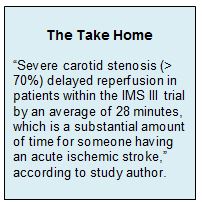Key Points:
- Study compares outcomes of IMS III based on degree of carotid stenosis
- Significant stenosis/occlusion associated with delayed reperfusion

Steven L. Gogela, MD, of the University of Cincinnati Medical Center (Cincinnati, OH), and colleagues categorized the 278 patients from the endovascular arm of IMS III based on degree of carotid stenosis, as determined by angiography. Next, they compared patients with severe stenosis or occlusion (≥ 70%) to those without severe stenosis (< 70%), with regard to time to endovascular reperfusion, mTICI score, 24-hour mean infarct volume, symptomatic intracerebral hemorrhage rate, and mRS score at 90 days.
Of these factors, only time to reperfusion was significantly different between the two groups (table 1).
Table 1. Outcomes by Degree of Stenosis
|
|
< 70% (n = 249) |
≥ 70 (n = 29) |
P Value |
|
Time to Reperfusion, mins |
77.7 ± 41.9 |
105.7 ± 42.2 |
.004 |
|
mTICI Score |
3.1 ± 1.2 |
2.9 ± 1.3 |
.47 |
|
24-Hour Infarct Volume |
81.8 ± 104.6 |
93.8 ± 99.9 |
.60 |
|
Symptomatic Intracranial Hemorrhage |
8.4% |
3.5% |
.71 |
|
90-Day mRS |
3.1 ± 2.0 |
3.4 ± 1.9 |
.42 |
In addition, multiple regression analysis revealed that severe carotid stenosis (P < 0.0001) and higher baseline NIHSS score (P = 0.004) were associated with an increase in time to reperfusion. Older age (P < 0.0001), higher NIHSS score (P < 0.0001), and the absence of reperfusion (P = 0.001) were associated with worse clinical outcomes.
Smaller Devices Needed
In an email to Neurovascular Exchange, Dr. Gogela described the average 28-minute difference in time to reperfusion between the 2 groups as “a substantial amount of time for someone having an acute ischemic stroke.
“While the devices used were not typically modern stentrievers,” he added, “we feel as though these more cumbersome modern devices would have an even more difficult time traversing severe stenosis, and thus our data has important implications for modern endovascular stroke treatment. . . . Interventionists need to be prepared with technology to address severe ICA stenosis upfront if identified on noninvasive imaging prior to intervention.”
In an effort to minimize the time to reperfusion, Dr. Gogela said, “our practice is to attempt to traverse the stenosis with a micro catheter and reserve angioplasty of the ICA only for cases where the devices are unable to traverse the stenosis. Stenting is performed at the end of the procedure only if there is rebound, flow-limiting stenosis.”
Given that outcomes were not influenced by degree of stenosis, Dr. Gogela said severe stenosis should not be considered a contraindication for reperfusion therapy. Rather, he advised, “if a patient is at the end of their therapeutic window for intervention, the presence of severe ICA stenosis may influence a decision not to treat given [the] potential delay [to successful reperfusion].”
He added that ongoing efforts to develop and design stroke treatments should take into account the need for smaller devices to effectively traverse severely stenotic segments.
Source:
Gogela SL, Gozal YM, Zhang B, et al. Severe carotid stenosis and delay of reperfusion in endovascular stroke treatment: an Interventional Management of Stroke-III study. J Neurosurg. 2017;Epub ahead of print.
Disclosures:
Dr. Gogela reports no relevant conflicts of interest.

